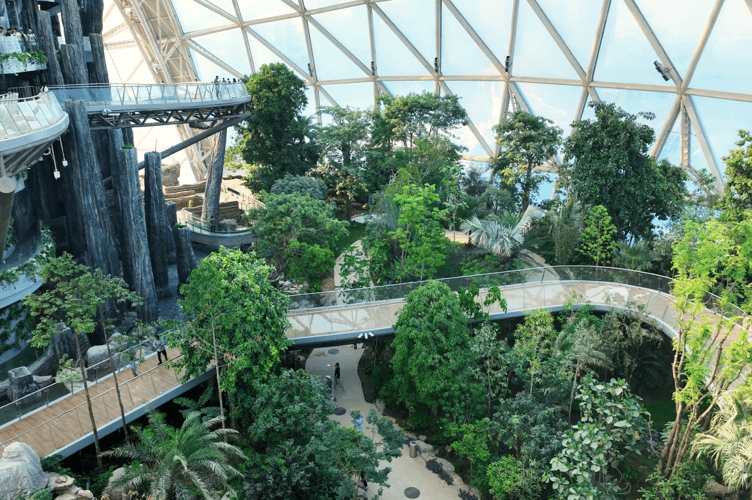A BREATHTAKING new chapter in global environmental storytelling has begun with the grand opening of Oriental Eden, China’s ambitious answer to the Eden Project in Cornwall.
Spanning 200 acres of reclaimed, once-polluted swampland on the edge of Jiaozhou Bay in Qingdao, Shandong Province, the new £150 million visitor attraction reimagines the connection between people, water and the natural world.
The monumental project – a decade in the making – is the result of a close collaboration between Chinese owner-operators Jinmao Holdings and the UK-based Eden Project. At its heart stands the Storm Forest, a vast tropical biome modelled on Cornwall’s famous rainforest dome, offering an immersive journey through living landscapes, performance, and play.
Eden Project founder Sir Tim Smit KBE and Orna NiChionna, Chair of the Eden Project Trust, attended the official opening, which marked the culmination of ten years of collaboration. Their presence underscored the significance of this latest global expansion of the Eden vision, one that began in a disused clay pit at Bodelva, near St Blazey 24 years ago.

Much like its UK predecessor and the upcoming Eden Project Morecambe in Lancashire (scheduled to open in 2028), Oriental Eden is deeply rooted in its environment. Positioned where a river meets the Yellow Sea, it takes water – its scarcity, abundance and quality – as its central theme.
Through a sequence of immersive, hyper-real experiences, visitors explore three interactive realms that bring the story of water to life, emotionally and intellectually engaging with some of the most urgent ecological challenges of our time.
Beyond its biomes and interactive installations, Oriental Eden also tells a bigger story – one of regeneration and hope. The site, once damaged by salt production and prawn farming, has been transformed into a vibrant ecological destination that echoes the Eden Project’s mission to restore landscapes and communities.
Situated halfway between Beijing and Shanghai, it’s poised to become a beacon of sustainable tourism in China.





Comments
This article has no comments yet. Be the first to leave a comment.